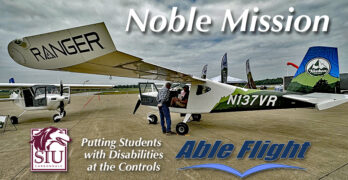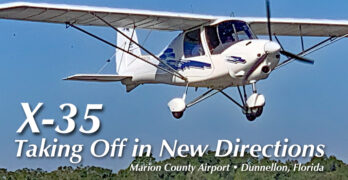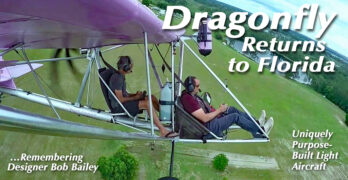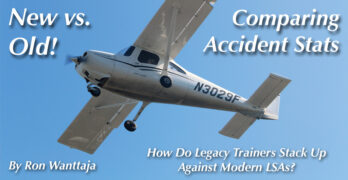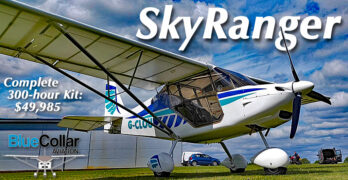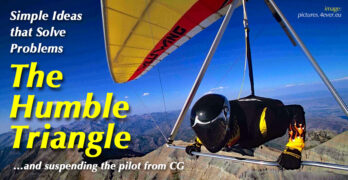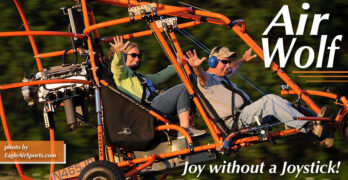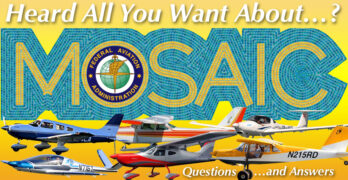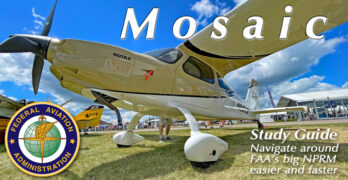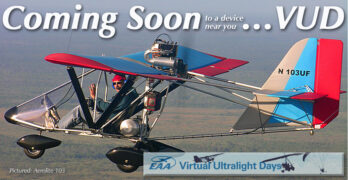What if you had a powerful interest in flying but you needed special equipment? I don’t mean flat-screen avionics, powerful engines, or comfortable seats — though all those are indeed fun.
Instead, I refer to people who want to fly but may have challenges many of us don’t face. If you had a passion for flight but you had lost the use of your legs, must you just give up?
Not if Charles Stites and Able Flight have anything to do with it. Of course, personal determination is also required.
Enabling Flight
Charles founded Able Flight in 2006 with a believe that, “the life-changing experience of learning to fly is best shared.” He carefully designed the Able Flight Scholarships to enable people with disabilities to pursue that experience and he’s been nothing short of amazing in his success at this. Over 18 years of operation, Able Flight has awarded 130 scholarships minting 98 new pilots.
Search Results for : powered parachute
Not finding exactly what you expected? Try our advanced search option.
Select a manufacturer to go straight to all our content about that manufacturer.
Select an aircraft model to go straight to all our content about that model.
Grassroots Success Story — Dunnellon’s X35 Attracts New, Younger Aviation Businesses
If I’ve heard one lament repeatedly over a long career, it is that current pilots don’t see enough new pilots coming into aviation. Are you one who worries a little or a lot about that? If not, you are a rare pilot.
Is it any wonder, though? The price of aircraft is way, way up. This applies to used aircraft and new — just like it does with your groceries or gasoline. The cost of maintenance is high and rising. Insurance is very expensive (for airplanes as well as cars or houses). Hangars are unavailable with years-long waiting lists at many airports.
More than ever it can seem, aviation is an activity for those with fairly thick wallets. The squeeze on modest budgets has rarely been this demanding.
Yeah, all that, but this website nonetheless discovers the affordable end of aviation. In that pursuit, I was drawn to an airport with an encouraging twist on the affordability squeeze play.
Dragonfly Is Back Home in Florida — Hang Glider Tug … Working Ranch “Tractor”
Dragonfly was born in Florida in the early 1990s. Back-of-the-napkin sketches started in the 1980s following the dynamic 1970s when hang gliding swooped into national awareness. What one designer did with Dragonfly would become one of the most celebrated developments in hang gliding.
Throughout the ’70s, hang glider designs accelerated smartly in glide performance and sink rate, stretching from slope-hugging 4:1 triangular-shaped wings to elegantly long and slender “bladewings” that could exceed a 20:1 glide yet remain foot-launchable and still be an aircraft you could carry on your shoulder (when folded down). Passionate enthusiasts thrilled to a 5X performance improvement in a decade or so.
In the beginning, most pilots launched off mountains to get enough height to catch thermals. Yet lots of America doesn’t have mountainous terrain. Florida had plenty of pilots eager to fly hang gliders but to find the best soaring, they had to load up their gliders and drive 10-12 hours to the hills of Tennessee where flight park operators like me catered to them with mountain launch sites.
Light Sport Accidents — New LSAs vs. Legacy Trainers
Editor’s Note: This is the second part of Ron Wanttaja’s survey of LSA safety (here’s the first). This time, he takes a close look at how modern LSAs compare with legacy trainers as epitomized by Cessna’s 152, both in terms of accident rates and the kinds of mayhem they succumb to. Let’s dive in!
In the previous safety review, we looked various forms of LSA—SLSA, ELSA and Experimental/Amateur-Built. For this article, we’ll look only at SLSA airplanes. We’re not addressing powered parachutes, weight shift or other SLSA classes—just traditional flying machines with wings and a motor. Call them “SLSA-A,” or “SLSA-As” for plural. We’ll address their accidents from 2005 through 2021.
To identify the SLSA-A accidents, I cross-referenced the NTSB accident database with FAA registrations, including both active and inactive aircraft.
What to compare them to? Let’s pick the near-ubiquitous Cessna 152. It’s close to the general definition of Light Sport, other than exceeding the LSA gross weight requirement.
Keeping Aircraft Affordable, Blue Collar Aviation Has a Flying Machine for Everyman
Tabor Coates calls his business Blue Collar Aviation. Honestly, as someone who scours the globe for affordable aircraft, any business with this name was certain to grab my attention.
This isn’t simply adroit marketing. Tabor’s Maynard, Massachusetts operation is deep into affordable aviation. How affordable? Tabor’s most-expensive offering is the SkyRanger Nynja (featured in this 2023 article and this flight report). With every item needed in the kit to include engine, instruments and coverings that need no paint, this tried-and-true light aircraft sells for $65,000 and that even includes freight from across the Atlantic.*
How deep into affordable goes Tabor? He offers two versions of SkyRanger — Swift III and Nynja — with a complete kit for the former starting at $49,985. If that’s still high for your budget Tabor offers FlyLight’s line of superlight (nanolight?) weight-shift trikes. The simplest of these flying machines are ready-to-fly for around $15,000.
Humble Triangle — Innovative Glider Control Mechanism Has a Nearly Unknown History
When Wilbur and Orville set out to fly their first airplane 120 years ago, aeronautical knowledge was rare and precious. Pioneers like Lilienthal preceded the Wright Brothers but the Ohio bike shop owners still had to figure out almost everything. They did so without funding, university degrees, or government help. Today, nearly every aviator celebrates their December 1903 achievement.
Aviation is a many-varied activity, though, and not all aircraft followed the same development path. Especially after World War II and the arrival of kit-built aircraft, American aviators began exploring in many directions.
Around the time NASA was pushing hard to land on the moon, a growing group of enthusiasts were jumping off mountains in pursuit of flight. Hang gliding soared into sky in the late 1960s and early 1970s. Enthusiasts grew to more than 100,000 active hang glider pilots globally, flying in nearly every country on Earth, perhaps as the most affordable of all aircraft.
Affordable, Fun, and a High Payload… What’s Not to Love about Powrachute’s AirWolf?
Last summer, when EAA AirVenture Oshkosh exploded with news that FAA released Mosaic, nearly all the attention was on increased weight and speed, and capabilities like retractable gear, controllable props, even multiengine or turbine aircraft. Christmas in July, I called it, so plentiful were FAA’s gifts to pilots and industry.
While all these items will add capability, they also increase prices. Is that what you want? Let me guess not for most readers. This website thrives on affordable aviation. Features that add substantial cost limit affordability.
Mosaic will trigger a bifurcation within the LSA community and it goes something like this: If you like the airplane you have now, you probably will not like the price of a Mosaic LSA. However, if you feel constrained in weight-carrying capacity or speed or if you want multiple engines, then Mosaic may address your wishes.
The great news? You can have it both ways.
Got Mosaic Fatigue? — Comments on FAA’s New Regulation from Two Presentations
I don’t know about you, but I can guess that Mosaic Fatigue is setting in to a lot of quarters. Some pilots have done an extraordinary job of digging into this 318-page document to distill essential parts that need to be addressed. Many pilots get exhausted just looking at the NPRM. …Me, too.
I look forward to more reporting on aircraft. Nonetheless…
Mosaic has given us an inside look at how FAA works. Many improvements resulted when industry worked in harmony with government officials. Nonetheless, careful study found areas of concern in the NPRM. Recent articles in other publications hit essentially the same points as I did in my talk (slide). Those points were partly my thinking, but I also relied on other experts to whom I had posed a variety of questions.
Still, some of the best commentary has come from non-experts, regular pilots who were concerned about a certain part of the NPRM and explored it thoroughly.
Making a Study of Mosaic Easier and Faster — LAMA & USUA Join Forces to Help You
FAA proposed regulation has powerfully captured the attention of many pilots. Pilots have tons of questions. We have some answers. Everyone has a lot to read.
But… uggghhh! Who wants to read this stuff? If it doesn’t put you to sleep, it might infuriate you.
Overall, FAA’s proposal has been warmly received as it opens the door to more capable aircraft that a Sport Pilot can fly. That’s good but the document has problems, too. Following are four examples…
This article is a longer, more challenging read than one about an aircraft.
If you prefer to listen or watch, I recommend the podcast and a video below.
Mosaic’s language invigorated many readers when the NPRM expressed support for a Sport Pilot (certificate holder) to fly at night — with proper training and a logbook endorsement. Yet then the proposal refers to other FAA regulations that require BasicMed or an AvMed. If you must have a medical, you are not exercising the central privilege of Sport Pilot.
Affordable Aviation Will Star in EAA’s Jam-Packed Ultralight Webinar Series
Brrrr, it’s mighty cold in northern places like Oshkosh, Wisconsin, headquarters for EAA. However, those seasoned veterans of winter’s chill know how to warm things up.
After Covid, so many things changed for so long that, today, it’s getting hard to remember how it was. EAA hosted (in-person) Ultralight Days for some years, with a wintery gathering of aviation’s lightest flying machines at their splendid facilities right behind the HQ building. Specifically I mean Pioneer Airport. Covid played a role in suspending that event.
Yet EAA’s helpful experts, led by Charlie Becker and Timm Bogenhagen, had a fresher idea. While corporations were Zoom-meeting with staff and clients, Timm and Charlie sprung into action. In the new age of working remotely, how could EAA convey lots of knowledge to their members and how could non-members get a great object lesson in how experts can help?
Using their system that worked beautifully for homebuilders, EAA cooked up Virtual Ultralight Days.
- « Previous Page
- 1
- 2
- 3
- 4
- 5
- …
- 45
- Next Page »


